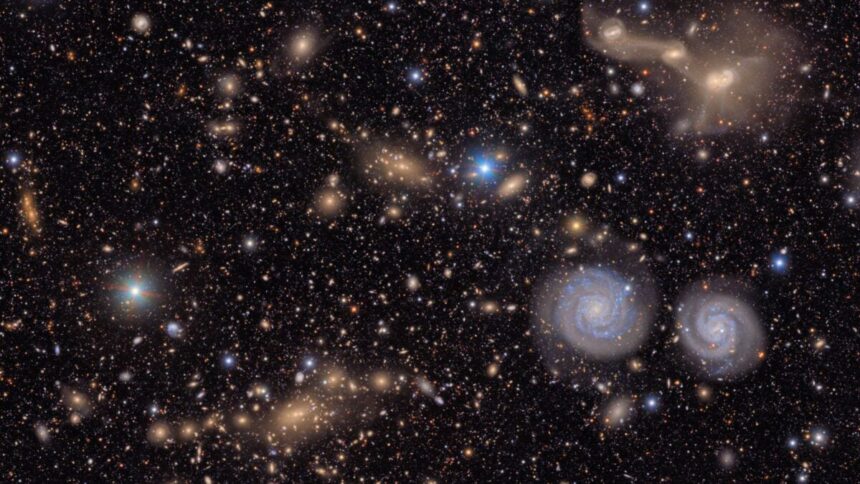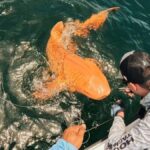Astronomers usually keep their eyes on the sky, but on Monday, June 23, the community turned its attention toward Washington, D.C., as scientists from the Vera C. Rubin Observatory unveiled the telescope’s first images. Many have waited more than 20 years to see Rubin in action, and its initial findings did not disappoint.
Rubin, a joint initiative of the National Science Foundation (NSF) and the Department of Energy’s (DOE) Office of Science, recently conducted its first 10 hours of test observations. In just that short period, the observatory produced dazzling images and discovered more than 2,000 previously unknown asteroids, including seven near-Earth asteroids. None of them pose a threat to our planet, but through this wealth of new data, the observatory has already proved to be a game changer for asteroid hunters working on planetary defense. By conducting unprecedentedly fast and detailed surveys of the entire southern sky, Rubin will allow scientists to find and track more space rocks than ever before.
“As this camera system was being designed, we all knew it was going to be breathtaking in what it delivered, but this has exceeded all our expectations,” Richard Binzel, a professor of planetary sciences at the Massachusetts Institute of Technology (MIT) and inventor of the Torino Scale—a tool for categorizing potential Earth impact events—told Gizmodo.
Data on those 2,000 new asteroids went directly to the International Astronomical Union’s Minor Planet Center (MPC), the globally recognized organization responsible for cataloging and disseminating data on asteroids, comets, and other small celestial bodies. It plays an essential role in the early detection and monitoring of asteroids that threaten Earth. The MPC has spent years preparing for the deluge of data from Rubin, ramping up its software to process massive amounts of observations. When the first round officially came flooding in on Monday, it was “nerve-racking and exciting simultaneously,” Matthew Payne, MPC director, told Gizmodo.
This was just a taste of what’s to come. In a few months, Rubin will begin the Legacy Survey of Space and Time (LSST), a decade-long, near-continuous survey of the southern sky. This will produce an ultrawide, ultra-high-definition time-lapse record of the universe. In terms of asteroids, that means the MPC will receive about 250 million observations per year from LSST, according to Payne. “For us, that’s a game changer in the total amount of data that we’re getting, because at the moment we get somewhere in the region of 50 to 60 million a year,” he said.
How does Rubin do it?
Rubin’s remarkable abilities stem from its remarkable instruments. Equipped with a unique three-mirror telescope design and the largest digital camera ever built, this observatory can conduct all-sky surveys while still detecting very faint objects like asteroids. This bridges a key gap between existing technologies, Payne explained.
When hunting space rocks, “you need to go as deep as possible,” Peter Veres, an MPC astrophysicist, told Gizmodo. “That’s what the LSST does, and none of the survey telescopes in the world that aim at planetary defense do that.” During this 10-year survey, Rubin will observe the cosmos on an automated schedule using its 27.6-foot (8.4-meter) Simonyi Survey telescope. Each 30-second exposure will cover an area about 45 times the size of the full Moon. Then, the enormous LSST camera will capture wide-field images and stitch them together to create a complete view of the southern sky every three nights. The combination of Rubin’s huge field of view, short exposure time, and its ability to rapidly sweep the sky will yield an avalanche of asteroid discoveries, Veres explained.
In 2005, Congress ordered NASA to build a near-Earth object (NEO) survey program to detect, track, catalogue, and characterize the physical characteristics of all near-Earth asteroids and comets at least 328 feet (100 meters) in diameter. If one of these objects struck our planet, it would cause mass destruction that would decimate life on a continental scale, Payne said. The goal was to find 90% of them by 2020, but current estimates show NASA has only found about 40%, he explained. LSST could help NASA pick up the pace. “It’s just going to start revolutionizing our understanding of this population of things,” Payne said.
Binzel agrees. “Those objects are out there, whether we see them or not,” he said. “Now we’re going to see them, and we’ll be able to determine that most—if not all of them—are going to safely pass by the Earth in the coming decades. But the best news is if an object has our name on it already, we will be able to find it most likely many, many years—if not decades—before it would come toward Earth.”
In theory, that would give NASA’s Planetary Defense Coordination Office (PDOC) time to launch a mission to intercept the asteroid. PDOC is still developing this capability, but in 2022, it launched the Double Asteroid Redirection Test (DART) mission, which sent a spacecraft on a 10-month-long journey to collide with the asteroid moonlet Dimorphos. The collision successfully changed Dimorphos’ orbital path, demonstrating NASA’s ability to deflect a large asteroid away from Earth if given enough time.
NASA not impressed?
Given Rubin’s clear potential to revolutionize planetary defense efforts—and the global attention it has received—one would expect NASA to be singing its praises. That has not been the case. The agency has kept strangely quiet about the observatory’s launch—and in fact, it appears to be ignoring Rubin’s first discoveries altogether.
“It’s a warp drive version of finding asteroids,” Keith Cowing, an astrobiologist and former NASA employee who now serves as editor of NASA Watch, told Gizmodo. “You’d think that the planetary defense people would be in the front row cheering it on, saying, ‘send me the data!’”
NASA did not share any public information about Monday’s event and has not promoted the observatory’s findings. When Gizmodo reached out for comment on Rubin’s contributions to planetary science and defense, NASA declined and recommended reaching out to the observatory instead.
On Tuesday, June 24, the agency’s Office of the Inspector General published a report on the implementation and management of NASA’s planetary defense strategy. The report only briefly mentions Rubin alongside NASA’s forthcoming NEO Surveyor, a space telescope designed to find asteroids that could hit Earth. “These new observatories are expected to find and track significantly more NEOs than current capabilities, which will likely mean a substantial increase in necessary follow-up observations,” the report states.
NASA’s PDCO and its planetary science program will undoubtedly use data gathered by the LSST, so what’s with the cold shoulder? Cowing thinks it’s a symptom of the agency’s inner turmoil. “They’re jittery at NASA,” he said. “Their budgets are being cut from all sides—they don’t know what the final budget will be, but the White House wants to slash it—and they’re having to react to this with whatever is at hand.”
Indeed, President Donald Trump’s 2026 budget proposal would cut NASA’s science funding by a whopping 47%, potentially killing more than 40 missions, according to The Planetary Society. “The only good news is what didn’t get shot,” Cowing said.
He suspects that most NASA employees—including planetary defense personnel—are in survival mode. “What do you do when you simply don’t know if you’ll have a job, if the person next to you will have a job, or if you’re gonna need to compete for the same job?” Cowing asked. “That’s what’s at the heart of this. It’s just this general malaise and fear, and people are simply not doing the routine, professional, collaborative, collegial work that they would do across agencies and countries.”
As NASA science crumbles, it’s unclear whether the agency will have the resources and personnel to take full advantage of Rubin’s data. Though the PDCO currently leads the world’s planetary defense efforts, that could soon change. Binzel, however, is optimistic. “Great nations do great science,” he said. “I continue to have faith that our nation will continue to do great science.
Read the full article here











